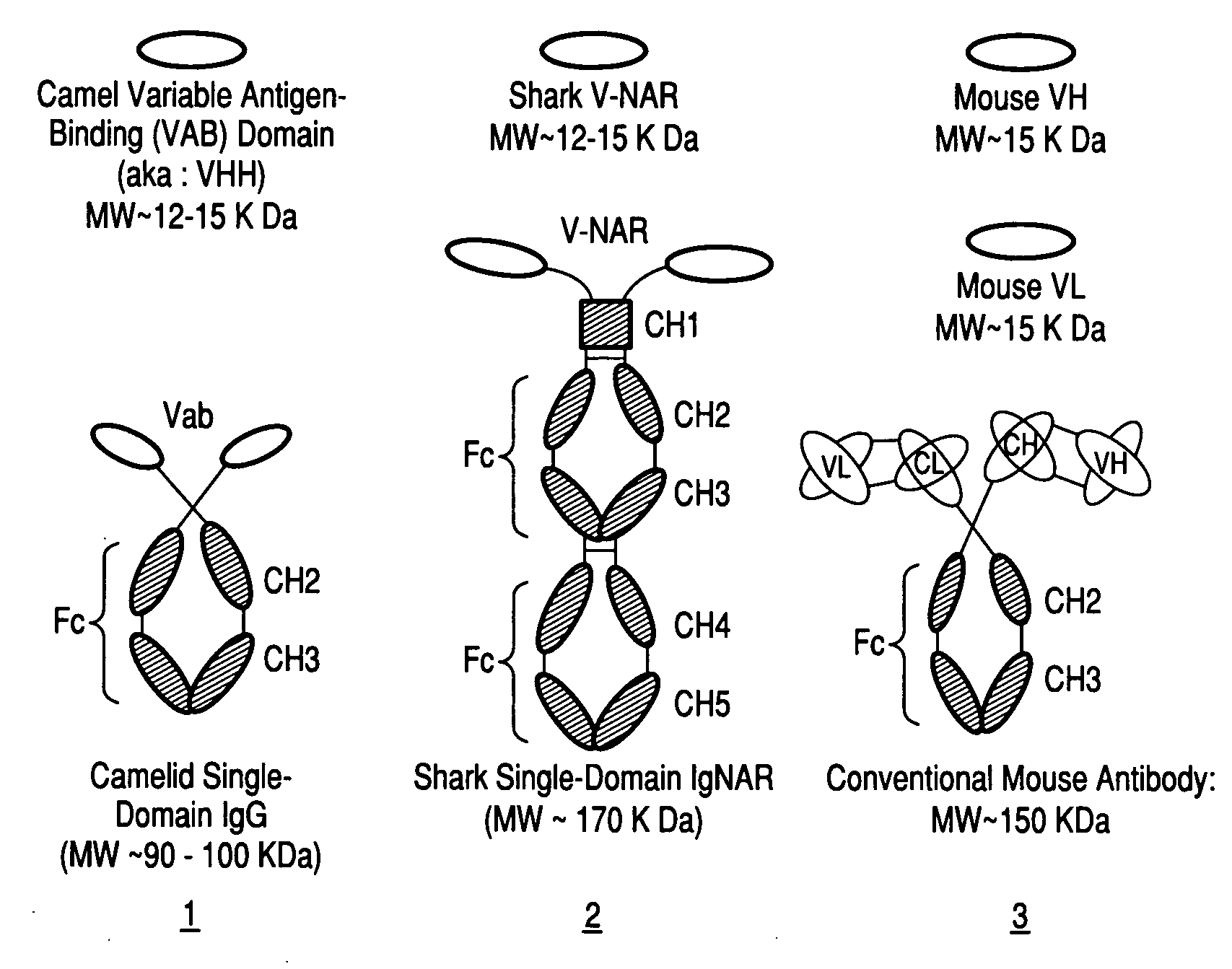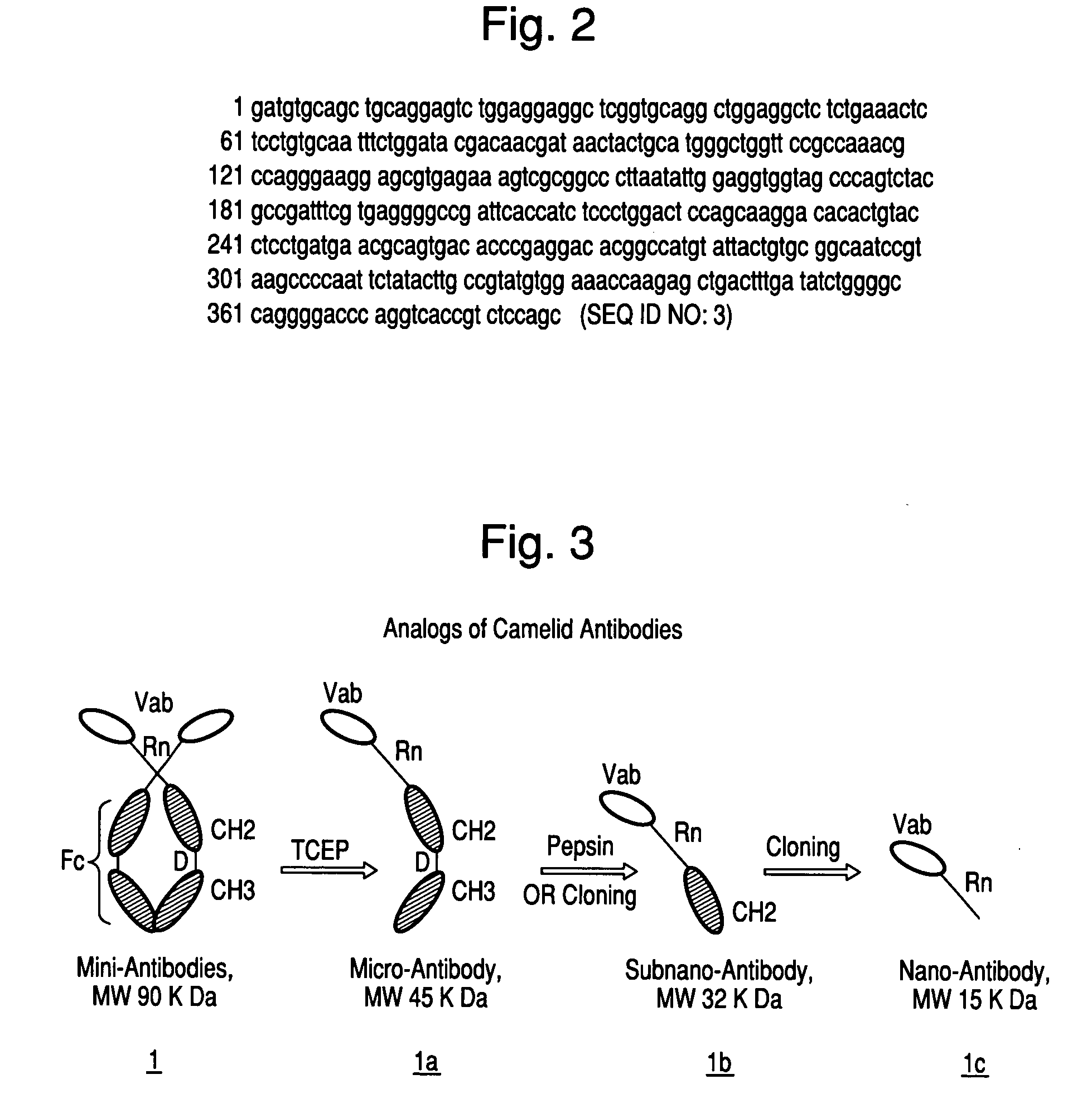Antibodies, analogs and uses thereof
- Summary
- Abstract
- Description
- Claims
- Application Information
AI Technical Summary
Benefits of technology
Problems solved by technology
Method used
Image
Examples
example 1
Production of Parent Heavy-Chain Mini-Antibodies (HCmnAbs) of Structure 1
[0664]Host animals such as camel, llama, or alpaca will be immunized with the desired antigen(s), for example B7-H3, a biomarker for prostate cancer or Amyloid-beta peptide antigenic peptide for detecting amyloid plaque, following the procedures described by Murphy et al, in 1989 [Am. J. Vet. Res., 50, 1279 (1989)], but with slight modification. Typically, immunization of camels is done with 50-100 ug immunogen per injection but 250 ug or higher amount of peptide per injection will be used, followed by 4 booster shots every two weeks after the initial injection. For baby sharks, 10 ug antigen / injection will be used. One antigen per animal for immunization will be used, though it may be feasible to immunize an animal simultaneously with multiple antigens to raise an immune response to each antigen separately, which can make the production cost effective [EMBO, J., 17, 3512 (1998); J. Immunol. Methods, 240, 185 (...
example 2
Recombinant Production of Micro, Sub-Nano- and Nano-Antibodies 1a, 1b, and 1c
[0666]mRNA Isolation: Nano-antibody 1c will be produced by recombinant means which will involve using 10 ml blood from immunized camels, isolating total RNA from peripheral blood lymphocytes (PBLs). mRNA will then be isolated using Nucleotrap® mRNA kit. About 10 ug mRNA will be used for preparing first strand of cDNA after oligo (dT) priming using high fidelity reverse transcriptase.
[0667]cDNA Preparation: DNA fragments encoding nano-antibody 1c (Vab-hinge region) will be amplified by PCR using 1.0 ug cDNA, 80 to 100 pmol of Vab primer SEQ ID NO: 5 and hinge-region specific SEQ ID NO: 6, respectively, 0.2 mM dNTPs, 1 mM MgCl2, 5 ul of 10×PCR buffer, and 0.6 ul Taq DNA Polymerase. After a first denaturation round of 94° C. for 10 minutes, 35 to 36 cycles of amplification will be performed under conditions as described below:
Denaturation:20 seconds at 94° C.Annealing:30 Seconds at 56° C.Extension:50 seconds a...
example 3
Library or Plasmid Construction
[0670]Prior to cloning the PCR amplicon encoding Vab-CH2-CH3 fragments of micro-antibody, vector and the amplicon DNA will be digested with Sfi1 and Not1 (Roche) following the cocktail:
Vab-CH2—CH3Vector (pJT1)DNA5ug10ug10× Restriction Buffer5ul5ulSfi1 (10U / ul)8ul4ulWater to50ul50ulIncubate 50° C. for 8 hourNot135U30UReaction Buffer4.5ul4.5ulWater to60ul60ulIncubate at 37° C. for 4-5hours.Ethanol Precipitate at −70° C.PelletPelletWater50ul50ulAgarose gel (1.5%)Pure DNAPure Vector DNApurificationEncoding micro-HCAbLibrary LigationVab-CH2—CH3 DNA =200ngVector DNA =1000ng10× Ligase Buffer =5ulT4 DNA Ligase =10UWater to =50ul
[0671]The reaction mixture will be incubated for 15 hours at 4° C., followed by ethanol precipitate at −70° C. The pellet will be suspended in 10 ul. Phage Display Vectors used will be either pFARBER (NFCR) or pLUCK (Pharmacia) or pJT1 (Sigma)
[0672]250 ul of E. Coli TG1 cells will be made electrocompetent with BRL Cell-Po...
PUM
| Property | Measurement | Unit |
|---|---|---|
| Temperature | aaaaa | aaaaa |
| Mass | aaaaa | aaaaa |
| Mass | aaaaa | aaaaa |
Abstract
Description
Claims
Application Information
 Login to View More
Login to View More - R&D
- Intellectual Property
- Life Sciences
- Materials
- Tech Scout
- Unparalleled Data Quality
- Higher Quality Content
- 60% Fewer Hallucinations
Browse by: Latest US Patents, China's latest patents, Technical Efficacy Thesaurus, Application Domain, Technology Topic, Popular Technical Reports.
© 2025 PatSnap. All rights reserved.Legal|Privacy policy|Modern Slavery Act Transparency Statement|Sitemap|About US| Contact US: help@patsnap.com



